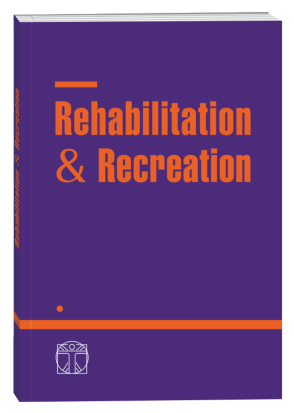SOMATOMETRICAL CHARACTERISTICS OF MALES 26–31 YEARS OLD WHO ARE ENGAGED IN HEALTHY FITNESS
DOI:
https://doi.org/10.32782/2522-1795.2024.18.3.15Keywords:
males, mature age, health, physical development, somatometric features, health fitnessAbstract
Introduction. As is known in modern science, the human body can acquire representation in a different way, objectively tangential to its elements, such as microscopic and ultramicroscopic structures, as well as qualitative and quantitative characteristics. At the current stage, representatives of not only the Ukrainian, but also foreign scientific communities show unanimity in the view that in today’s conditions, one of the biggest problems of males of mature age is a significant decrease in the level of physical condition and health. The aim of the research is to determine the somatometric features of males aged 26–31. Methods of research: theoretical analysis and generalization of literature sources; anthropometry, pedagogical experiment, photography and posture analysis, methods of mathematical statistics. The results. As studied results of anthropometric measurements evidenced, most males (81.8%) have a body weight that corresponds to the norm, however, some males (18.2%) show a tendency to excess body weight. Accordingly, among males, the majority has an average and harmonious level of physical conditions (54.5%), but there are also fat individuals (45.5%). Thus, more than half of participants of the study (63.6%) were characterized by an acceptable ratio of waist and hips, but the rest fell into the zone of moderately high risk. Regarding the differences, males aged 29–31 years showed a general tendency to gain body weight, reflected in higher values of body mass index and Rohrer index, and excess waist and hip circumferences in the older group indicated accumulation of adipose tissue and a general increase in body volume. From this we can say that the differences between the groups of males aged 26–28 years and 29–31 years indicate a tendency to increase body weight and corresponding anthropometric indicators with age. Conclusions. The analysis of the data showed that there were significant differences between males aged 26–28 and males aged 29–31 according to most weight-height indicators of physical conditions (body weight, BMI, Rohrer index). Males aged 29–31 years had higher average values of body weight, BMI and Rohrer index compared to males aged 26–28 years, which indicated a tendency of increasing of body weight and increasing the respective indices with age. At the same time, the average body lengths in these age groups were similar and had no statistically significant differences.
References
Ватаманюк С. Підвищення рівня стану біогеометричного профілю постави чоловіків зрілого віку засобами оздоровчого фітнесу : дис. … доктора філ. : 017. Київ. 2023. 224 с.
Кашуба В., Попадюха Ю. Біомеханіка просторової організації тіла людини: сучасні методи та засоби діагностики і відновлення порушень : монографія. Київ : Центр учбової літератури, 2018. 768 с.
Кашуба В., Гончарова Н., Носова Н. Біомеханіка просторової організації тіла людини: теоретичні та практичні аспекти Теорія і методика фізичного виховання і спорту. 2020. 2. 67–85.
Кашуба В.О., Григус І.М., Руденко Ю.В. Стан просторової організації тіла осіб зрілого віку: виклик сьогодення. Influence of physical culture and sports on the formation of an individual healthy lifestyle : Scientific monograph. Riga, Latvia : Baltija Publishing. 2023. Рp. 56–68. DOI: https://doi.org/10.30525/978-9934-26-280-7-3.
Корекція тілобудови людини в процесі занять фізичними вправами: теоретичні та практичні аспекти : кол. моногр. / за наук. ред. А.І. Альошиної, І.П. Випасняка, В.О. Кашуби. Луцьк : Вежа-Друк, 2022. 536 с.
Руденко Ю.В. Корекція порушень стану біогеометричного профілю постави чоловіків зрілого віку в процесі занять оздоровчим фітнесом : дис … доктора філ. : 017. Київ. 2021. 254 с.
Grygus I., Dolishnyi M., Rebrov V. Goniometric body profile of men 26–31 years old engaged in health-improving fitness. Physical rehabilitation and recreational health technologies. 2024. 9(5). 362–369. https://doi.org/10.15391/prrht.2024-9(5).03.
Hakman A., Andrieieva O., Kashuba V., Nakonechnyi I., Cherednichenko S., Khrypko I., Tomilina Yu., Filak F. Characteristics of Biogeometric Profile of Posture and Quality of Life of Students During the Process of Physical Education. Journal of Physical Education and Sport. 2020. 20. (1). 79–85. https://doi.org/10.7752/jpes.2020.01010.
Kashuba V., Rudenko Y., Khabynets T., Nosova N. Use of correctional technologies in the process of health-recreational fitness training by men with impaired biogeometric profile of posture. Pedagogy and Psychology of Sport. 2020. 6. (4). 45–55. elSSN 2450-6605. DOI: http://dx.doi.org/10.12775/PPS.2020.06.04.005.
Kashuba V., Khmelnitska I., Andrieieva O. et al. Biogeometric Profile of the Posture as a Factor of Men’s Functional Assessment of Movements in the Early Middle Age. Sport Mont. 2021. 19. (2). 35–39. DOI: 10.26773/smj.210907.
Matiichuk V.I., Grygus I.M., Kashuba V.O. Postural control of student of different body types methods of students’ rehabilitation of military personnel, status. Rehabilitation & Recreation : scientific journal. Rivne : Vidavnichy house “Helvetica”, 2024.18, 1. Pp. 70–77.
Downloads
Published
How to Cite
Issue
Section
License
Copyright (c) 2024 М. В. Долішній, А. В. Магльований, В. В. Ребров

This work is licensed under a Creative Commons Attribution-NonCommercial-NoDerivatives 4.0 International License.












